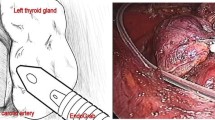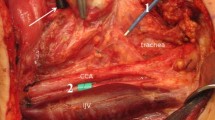Abstract
Purpose
Intraoperative neuromonitoring has the limitation that the recurrent laryngeal nerve (RLN) is still at risk for damage between two stimulations with a handheld bipolar stimulation electrode. The purpose of this study was to establish the vagal anchor electrode for real-time monitoring of the RLN in surgical routine and to be alerted to imminent nerve failure by electromyography (EMG) signal analysis whereby the nerve damage becomes reversible.
Patients and methods
This fully implantable electrode has been used in addition to a conventional handheld bipolar stimulation electrode during thyroid surgery on 45 consecutive patients (78 nerves at risk) stratified to low- and high-risk groups. The signal analysis was performed as real-time audio/video feedback by the use of a new multichannel EMG system.
Results
No complications were attributable to the use of the anchor electrode. The mean delay to place the anchor electrode was 1.45 min, whereas the mean stimulation time of the vagus nerve was 38 min. Stable and repeatable signals were evocable in all cases with one exception. No permanent RLN paralyses occurred in this study.
Conclusions
The vagal anchor electrode is safe and easy to use. It allows continuous neuromonitoring without any threats. The new technique will provide more security, especially during preparation steps on the RLN that are difficult for the surgeon.



Similar content being viewed by others
References
Agnew WF, McCreery DB (1990) Considerations for safety with chronically implanted nerve electrodes. Epilepsia 31:27–32. doi:10.1111/j.1528-1157.1990.tb05845.x
Beldi G, Kinsbergen T, Schlumpf R (2004) Evaluation of intraoperative recurrent nerve monitoring in thyroid surgery. World J Surg 28:589–591. doi:10.1007/s00268-004-7226-6
Bernards CM (2004) An unusual cause of airway obstruction during general anesthesia with a laryngeal mask airway. Anesthesiology 100:1017–1018. doi:10.1097/00000542-200404000-00037
Brennan J, Moore EJ, Shuler KJ (2001) Prospective analysis of the efficacy of continuous intraoperative nerve monitoring during thyroidectomy, parathyroidectomy, and parotidectomy. Otolaryngol Head Neck Surg 124:537–543. doi:10.1067/mhn.2001.115402
Chan WF, Lo CY (2006) Pitfalls of intraoperative neuromonitoring for predicting postoperative recurrent laryngeal nerve function during thyroidectomy. World J Surg 30:806–812. doi:10.1007/s00268-005-0355-8
Chan WF, Lang BH, Lo CY (2006) The role of intraoperative neuromonitoring of recurrent laryngeal nerve during thyroidectomy: a comparative study on 1000 nerves at risk. Surgery 140:866–872. doi:10.1016/j.surg.2006.07.017
Chiang FY, Lu IC, Kuo WR, Lee KW, Chang NC, Wu CW (2008) The mechanism of recurrent laryngeal nerve injury during thyroid surgery-the application of intraoperative neuromonitoring. Surgery 143:743–749. doi:10.1016/j.surg.2008.02.006
Dralle H, Sekulla C, Haerting J, Timmermann W, Neumann HJ, Kruse E et al (2004) Risk factors of paralysis and functional outcome after recurrent laryngeal nerve monitoring in thyroid surgery. Surgery 136:1310–1322. doi:10.1016/j.surg.2004.07.018
Dralle H, Sekulla C, Lorenz K, Brauckhoff M, Machens A (2008) Intraoperative monitoring of the recurrent laryngeal nerve in thyroid surgery. World J Surg 32:1358–1366. doi:10.1007/s00268-008-9483-2
Eltzschig HK, Posner M, Moore FD (2002) The use of readily available equipment in a simple method for intraoperative monitoring of recurrent laryngeal nerve function during thyroid surgery. Arch Surg 137:452–457. doi:10.1001/archsurg.137.4.452
Friedman M, Toriumi DM, Grybauskas VT, Applebaum EL (1989) Implantation of a recurrent laryngeal nerve stimulator for the treatment of spastic dysphonia. Ann Otol Rhinol Laryngol 98:130–134
Groves DA, Brown VJ (2005) Vagal nerve stimulation: a review of its applications and potential mechanisms that mediate its clinical effects. Neurosci Biobehav Rev 29:493–500. doi:10.1016/j.neubiorev.2005.01.004
Hatton KW, McLarney JT, Pittman T, Fahy BG (2006) Vagal nerve stimulation: overview and implications for anesthesiologists. Anesth Analg 103:1241–1249. doi:10.1213/01.ane.0000244532.71743.c6
Hermann M, Hellebart C, Freissmuth M (2004) Neuromonitoring in thyroid surgery: prospective evaluation of intraoperative electrophysiological responses for the prediction of recurrent laryngeal nerve injury. Ann Surg 240:9–17. doi:10.1097/01.sla.0000132260.34503.02
Jonas J (2002) Reliability of intraoperative recurrent laryngeal nerve monitoring in thyroid surgery. Zentralbl Chir 127:404–408. doi:10.1055/s-2002-31981
Lamadé W, Meyding-Lamadé U, Hund E, Senninger N, Herfarth C (1997) Transtracheal monitoring of the recurrent laryngeal nerve. Prototype of a new tube. Chirurg 68:193–195. doi:10.1007/s001040050173
Lamadé W, Meyding-Lamadé U, Buchhold C, Brauer M, Brandner R, Uttenweiler V et al (2000) First continuous nerve monitoring in thyroid gland surgery. Chirurg 71:551–557. doi:10.1007/s001040051186
Lamadé W, Ulmer C, Seimer A, Molnar V, Meyding-Lamadé U, Thon KP et al (2007) A new system for continuous recurrent laryngeal nerve monitoring. Minim Invasive Ther Allied Technol 16:149–154. doi:10.1080/13645700701383241
Leonetti JP, Mokarry VP, Fan Z, Warf P, Hudson E (1994) Vagal nerve monitoring during parapharyngeal space tumor removal. Skull Base Surg 4:213–218. doi:10.1055/s-2008-1058957
Loch-Wilkinson TJ, Stalberg PL, Sidhu SB, Sywak MS, Wilkinson JF, Delbridge LW (2007) Nerve stimulation in thyroid surgery: is it really useful? ANZ J Surg 77:377–380. doi:10.1111/j.1445-2197.2007.04065.x
Pott L, Swick JT, Stack BC Jr (2007) Assessment of recurrent laryngeal nerve during thyroid surgery with laryngeal mask airway. Arch Otolaryngol Head Neck Surg 133:266–269. doi:10.1001/archotol.133.3.266
Robertson ML, Steward DL, Gluckman JL, Welge J (2004) Continuous laryngeal nerve integrity monitoring during thyroidectomy: does it reduce risk of injury? Otolaryngol Head Neck Surg 131:596–600. doi:10.1016/j.otohns.2004.05.030
Shindo M, Chheda NN (2007) Incidence of vocal cord paralysis with and without recurrent laryngeal nerve monitoring during thyroidectomy. Arch Otolaryngol Head Neck Surg 133:481–485. doi:10.1001/archotol.133.5.481
Snyder SK, Hendricks JC (2005) Intraoperative neurophysiology testing of the recurrent laryngeal nerve: plaudits and pitfalls. Surgery 138:1183–1191. doi:10.1016/j.surg.2005.08.027
Sturgeon C, Sturgeon T, Angelos P (2009) Neuromonitoring in thyroid surgery: attitudes, usage patterns, and predictors of use among endocrine surgeons. World J Surg 33:417–425. doi:10.1007/s00268-008-9724-4
Thomusch O, Sekulla C, Machens A, Neumann HJ, Timmermann W, Dralle H (2004) Validity of intra-operative neuromonitoring signals in thyroid surgery. Langenbecks Arch Surg 389:499–503. doi:10.1007/s00423-003-0444-9
Timmermann W, Hamelmann WH, Thomusch O, Sekulla C, Grond S, Neumann HJ et al (2004) Effectiveness and results of intraoperative neuromonitoring in thyroid surgery. Statement of the Interdisciplinary Study Group on Intraoperative Neuromonitoring of Thyroid Surgery. Chirurg 75:916–922. doi:10.1007/s00104-004-0858-0
Tomoda C, Hirokawa Y, Uruno T, Takamura Y, Ito Y, Miya A et al (2006) Sensitivity and specificity of intraoperative recurrent laryngeal nerve stimulation test for predicting vocal cord palsy after thyroid surgery. World J Surg 30:1230–1233. doi:10.1007/s00268-005-0351-z
Ulmer C, Koch KP, Seimer A, Molnar V, Meyding-Lamadé U, Thon KP et al (2008) Real-time monitoring of the recurrent laryngeal nerve: an observational clinical trial. Surgery 143:359–365. doi:10.1016/j.surg.2007.10.007
Yarbrough DE, Thompson GB, Kasperbauer JL, Harper CM, Grant CS (2004) Intraoperative electromyographic monitoring of the recurrent laryngeal nerve in reoperative thyroid and parathyroid surgery. Surgery 136:1107–1115. doi:10.1016/j.surg.2004.06.040
Acknowledgements
This work was supported by a grant from Dr. Langer Medical GmbH, Waldkirch, Germany. We are very grateful to Dr. Andreas Langer and Daniel Haberstroh from Dr. Langer Medical GmbH, Waldkirch, Germany, for administrative, technical, and material support. The authors wish to thank Dr. Uwe Pliquett, Institute for Bioprocessing and Analytical Measurement Techniques, Heiligenstadt, Germany, for technical support, Dr. Uta-Carolin Pietsch and Dr. Markus Wehner, University Hospital Leipzig, Department of Anesthesia and Intensive Care, Leipzig, Germany, for their excellent assistance and Lila Hunt for her kind support in proofreading this paper.
Author information
Authors and Affiliations
Corresponding author
Rights and permissions
About this article
Cite this article
Schneider, R., Przybyl, J., Hermann, M. et al. A new anchor electrode design for continuous neuromonitoring of the recurrent laryngeal nerve by vagal nerve stimulations. Langenbecks Arch Surg 394, 903–910 (2009). https://doi.org/10.1007/s00423-009-0503-y
Received:
Accepted:
Published:
Issue Date:
DOI: https://doi.org/10.1007/s00423-009-0503-y




